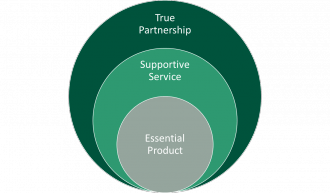From Data to Impact… and Beyond!
Last week, Adrian Bordone of GuideStar gave the keynote address at our annual Nonprofit Finance and Sustainability Conference, where he extolled the bold use of data to counter the overhead myth. He encouraged the sell-out crowd of nonprofit executives, finance leaders, and board members to use data to craft a sophisticated case demonstrating the positive changes our nonprofits are making in the world. Most of those present were already savvy to the message – nonprofit leaders are keenly aware that in the digital age, data about our organizations is widely accessible to the public and open for interpretation. So while the call to tell our story with data was well-received, the crowd was eager to move from data to impact… and beyond!
Many of the breakout sessions following the keynote focused on alternative ways to tell stories about our organizational impact and effectiveness. The nonprofit sector is currently waging a campaign against the outdated reliance on overhead percentage as a meaningful measure of an organization’s efficiency and the short-sighted reliance on service outputs as a measure of an organization’s effectiveness. As Adrian said in his keynote, in order to dispel the overhead myth, our responsibility is to backfill with something more compelling.
Our own Kate Barr joined Adrian in a session immediately following the keynote where the Performance Imperative was highlighted as a more meaningful framework from which to define organizational effectiveness. Instead of defining our success by units served and an overhead ratio, the value of an organization’s long-term impact is based on seven pillars that range from courageous leadership to continuous improvement to well-designed and well-implemented programs and strategies. As nonprofits, it is our responsibility to tell our stories more completely, including these qualitative measures, in order to avoid reinforcing the too-narrow trust in ratios and statistics.
In a session on the power of evaluation, Janet Ogden-Brackett of our staff and Al Onnka of Aurora Consulting shared insights gained from an open-ended impact evaluation. In the evaluation process, we discovered that nonprofits using a combination of our services reported that their organization, its financial strength, and the confidence of its leaders were truly transformed. What emerged was a new framework for describing our mission success as a combination of an essential product, coupled with supportive service, which culminated in true partnership with our clients. The takeaway for nonprofit leaders is that deep evaluation of this kind moves beyond balancing, reconciling, and tying together output data. Well-crafted evaluation evokes candid feedback from clients, gives us insight into the ways we are meeting their needs, and inspires us to even better service. It creates value for staff as they learn what makes their service delivery truly effective. Having a new vocabulary for our impact gives us innovative options for describing ourselves to our clients, funders, and the public.

In our session titled “Finance Imitates Program”, we talked about building financial infrastructure that mirrors and amplifies our programs. By strategically using the tools of accounting, we can design systems that allow us to capture our mission work in financial terms. Elegantly designed financial systems enable us to better report and present our work to specific audiences. A thoughtfully constructed accounting system can help us break out of old thinking that separates infrastructure costs from our programs and the organization as a whole. The diagram below illustrates how we can begin to alter the conception of overhead. Rather than seeing our infrastructure as a bite taken out of our organization, we need to start envisioning it, and communicating about it, as core mission support. Administration and fundraising take their rightful place at the core of our organizations. As we strengthen and develop our core, the entire organization is bolstered and expanded.

The nonprofit sector is becoming more sophisticated and more adept at using data to demonstrate impact. But focusing solely on quantitative measures may not get us far enough. We must be careful not to simply shift the focus from the overhead ratio to some other quantitative measure that remains too narrow and insufficient to adequately showcase our mission successes. It is our job to present a full picture of our impact that includes qualitative assessments of our work alongside quantitative information. In order to counter the overhead myth, we’ve got to move from data to impact… and beyond!

